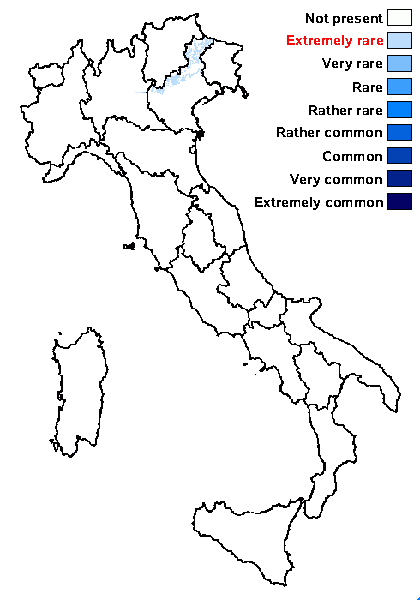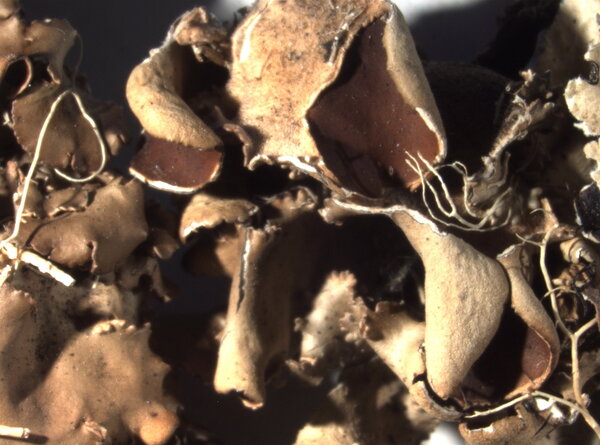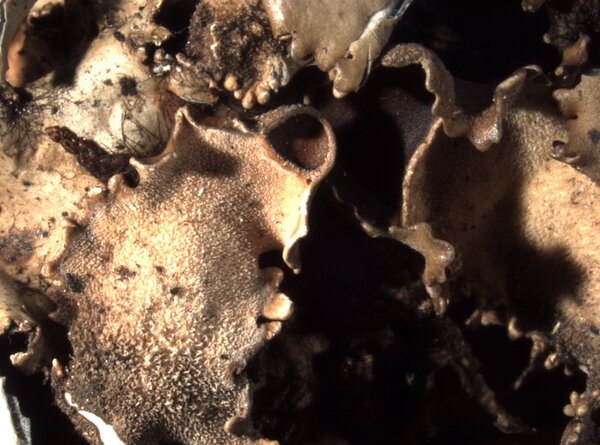Nephroma tropicum (Müll. Arg.) Zahlbr.
Cat. Lich. Univ., 3: 442, 1925. Basionym: Nephromium tropicum Müll. Arg. - Flora, 66: 21, 1883
Synonyms: Nephroma helveticum subsp. sipeanum (Gyeln.) Goward & Ahti ; Nephroma helveticum var. sipeanum (Gyeln.) Wetmore; Nephroma sipeanum Gyeln.
Distribution: N - Ven (Timdal & al. 2021, Ravera & al. 2022).
Description: Thallus foliose, heteromerous and dorsiventral, loosely adnate, leathery, >0.20 mm thick, forming regular to irregular, 3-4(-8) cm wide rosettes. Lobes 2-5 mm wide, elongate, with subrotund apices, the margins frequently toothed, the fertile lobes with obtuse teeth measuring 0.6-1 x c. 0.3 mm. Upper surface grey-brown to dark brown when dry, much darker when wet, smooth, finely pubescent, isidiate-phyllidiate, the isidia at first cylindrical, then flattened, 0.1-0.2 mm in diam., mostly marginal but later expanding on the upper surface. Lower surface dark brown to black, paler at margins, pubescent or tomentose, not papillate. Upper and lower cortex paraplectenchymatous; medulla white. Apothecia common, immersed on lower surface at tips of lobes, up to 8 mm across, cup-shaped, sessile, with a brown disc and a distinct, uplifted margin, the dorsal surface smoothly ridged, without tomentum. Epithecium brownish; hymenium and hypothecium colourless. Asci 8-spored, fissitunicate, the thickened apex with a K/I+ blue ring, Peltigera-type. Ascospores 3-septate, pale brown, subfusiform, thick-walled, most of them 20-24 x 5.5-6 μm. Pycnidia immersed, punctiform, Conidia bacilliform, 3-4 x 1-2 µm. Photobiont cyanobacterial (Nostoc, the cells not in long chains). Spot tests: upper cortex K-, C-, KC-, P-; medulla K+ pale yellow or K-, C-, KC-, P-. Chemistry: upper cortex with an unknown brown pigment; medulla with hopane-7β,22-diol and other terpenoids.Note: an extremely rare species with tropical affinities, growing on the often mossy bark of deciduous trees in humid shaded situations. It is best distinguished from N. helveticum by molecular data; for further details see Timdal & al. (2021).
Growth form: Foliose, broad lobed
Substrata: bark
Photobiont: cyanobacteria, filamentous (e.g. Nostoc, Scytonema)
Reproductive strategy: mainly sexual
Restricted to humid-warm, oceanic areas
Commonnes-rarity: (info)
Alpine belt: absent
Subalpine belt: absent
Oromediterranean belt: absent
Montane belt: extremely rare
Submediterranean belt: absent
Padanian area: absent
Humid submediterranean belt: absent
Humid mediterranean belt: absent
Dry mediterranean belt: absent

Predictive model
Herbarium samples
Growth form: Foliose, broad lobed
Substrata: bark
Photobiont: cyanobacteria, filamentous (e.g. Nostoc, Scytonema)
Reproductive strategy: mainly sexual
Restricted to humid-warm, oceanic areas
Commonnes-rarity: (info)
Alpine belt: absent
Subalpine belt: absent
Oromediterranean belt: absent
Montane belt: extremely rare
Submediterranean belt: absent
Padanian area: absent
Humid submediterranean belt: absent
Humid mediterranean belt: absent
Dry mediterranean belt: absent

Predictive model
| Herbarium samples |
 Index Fungorum
Index Fungorum
 GBIF
GBIF




